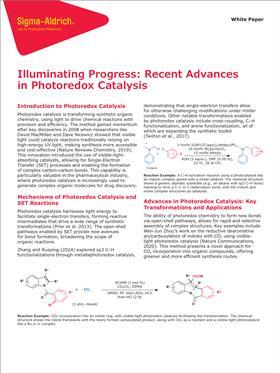Illuminating progress: recent advances in photoredox catalysis

In this free download, shed some light on the latest developments in photoredox for drug development and materials science

Electrochemistry is a foundational technique in chemical reactions, using electrical currents to drive oxidation and reduction reactions and facilitate precise molecular transformations. Originally pioneered by Michael Faraday, electrochemistry is experiencing a revival in synthetic chemistry, offering a greener, more efficient alternative to traditional methods.
Download now to discover how:
- Photoredox catalysis uses light to drive chemical reactions, making synthetic organic chemistry more efficient and accessible, especially in pharmaceutical applications
- Recent advancements, including the use of visible-light-absorbing catalysts and flow chemistry, have improved the scalability and consistency of these reactions, addressing challenges in industrial applications.
- This technique offers a greener alternative to traditional methods by reducing the need for harsh reagents and high temperatures, aligning with sustainability goals in the chemical industry.
- Photoredox catalysis enables Single-Electron Transfer (SET) processes, which allow for the formation of complex carbon-carbon bonds and broaden the scope of synthetic transformations.
- Ongoing research and technological advancements are expected to further expand the applications of photoredox catalysis, particularly in drug development and materials science.
